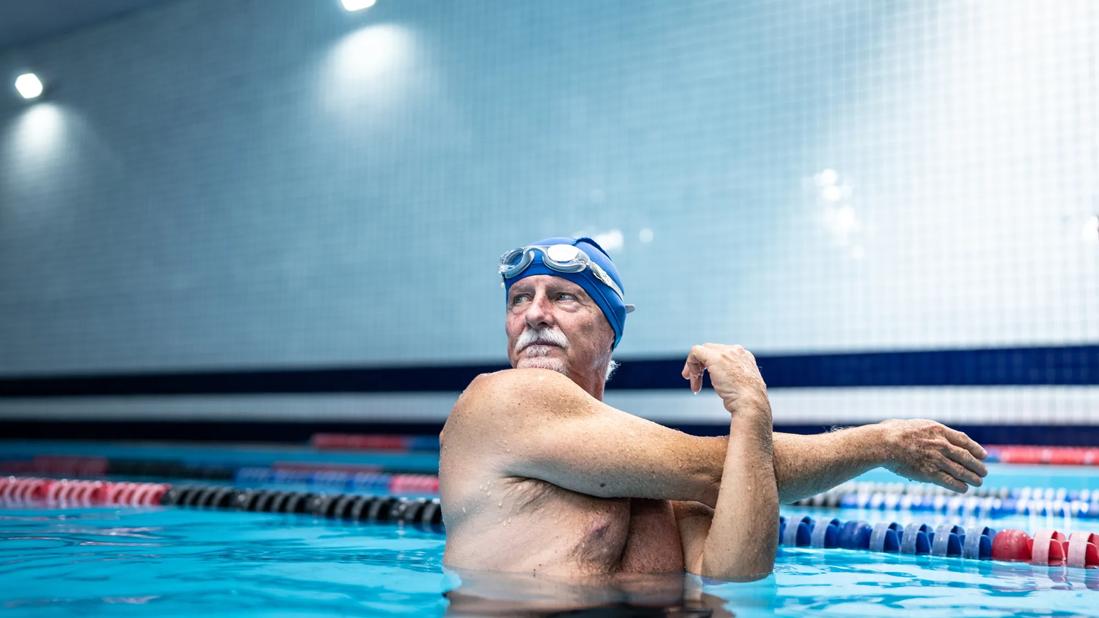Moderate-intensity exercise, like walking, cycling and swimming, is typically recommended

When it comes to your heart health, exercise is key in lowering the risk of heart disease, stroke and high blood pressure. But if you have aortic stenosis, can you still work out? And if so, what types of exercise are best?
Advertisement
Cleveland Clinic is a non-profit academic medical center. Advertising on our site helps support our mission. We do not endorse non-Cleveland Clinic products or services. Policy
Cardiologist L. Leonardo Rodriguez, MD, explains the different aortic stenosis guidelines.
It’s generally OK for people with aortic stenosis to exercise. But Dr. Rodriguez says it all depends on factors like your symptoms and how advanced your heart condition is (mild, moderate or severe). The degree of exercise allowed should be recommended by your doctor.
Aortic stenosis happens when there’s a narrowing or blockage of your aortic valve. This makes it more difficult for blood to pass. And when you exercise, your heart works harder. For people with severe aortic stenosis, this can cause symptoms, like chest pain and shortness of breath, and other complications, like reduced blood flow to the rest of your body.
Your doctor may suggest an exercise stress test to help determine what intensity of exercise is best for you. During a stress test, you’ll exercise in a medical setting while being monitored by medical professionals.
“We just want to be sure that there are zero abnormalities, that the electrocardiogram (ECG) remains normal and that you don’t have any arrhythmia (irregular heart rhythm) with exercise,” explains Dr. Rodriguez. “It’s a way to confirm exactly how much exercise you can do under supervised conditions.”
Advertisement
If you have mild or moderate aortic stenosis, your doctor may recommend low-impact, moderate-intensity exercise, like:
“Unless your aortic stenosis is severe, we’re typically liberal with exercise,” clarifies Dr. Rodriguez. “We prefer some type of aerobic exercise. You can only do strength training up to a certain point because it can cause an elevation of your blood pressure.”
If you have severe aortic stenosis, you’ll need to adjust your workout based on recommendations from your doctor. For example, you may need to avoid or modify yoga poses that result in your head being below your heart, as that can increase your blood pressure. If symptoms are present, strenuous exercise should be avoided until the problem is resolved.
Per general exercise guidelines, aim to get at least 150 minutes of moderate-intensity exercise per week, unless your doctor advises otherwise.
In most cases, your doctor may recommend avoiding strenuous or vigorous exercise and activity.
“Strenuous exercise is when you’re working at 70% to 80% of your predicted heart rate,” says Dr. Rodriguez.
Exercises and activities you may need to avoid include:
Keep these pointers in mind when you’re exercising:
In most situations, you won’t need to limit or adjust your activity. “We encourage people with less than severe aortic stenosis to be active,” reiterates Dr. Rodriguez.
Advertisement
But, again, make sure you work with your doctor to figure out what type of exercise is right for you before starting any kind of exercise program. It’s important to be aware of how your body is responding when engaging in physical activity.
Stop exercising and talk to your doctor if you experience:
“It’s important to be active,” concludes Dr. Rodriguez. “There’s a relationship between physical activity and longevity. Exercise plays a vital role in your heart health.”
Advertisement
Learn more about our editorial process.
Advertisement

All heart valve diseases affect your heart’s valves, but there are some differences between symptoms, risk factors and how they can impact your health

The heart condition can advance at different rates, and typically can be classified as mild, moderate or severe

You can improve your athletic performance over time by breaking up your workout regimen into focused cycles

Physical activity can help preserve and improve your cognitive function and fend off dementia, stroke and other health concerns

Lower-intensity workouts can deliver high-quality health and fitness results

Incremental changes in your exercise routine can improve your strength and endurance over time

Understanding heart rate zones can help you tailor your workout to reach your goals

Increase the size of your muscles by bulking up on protein and focusing on slow, intense movements with progressive overloading

Babies can get congested easily, but you can calm their cough by keeping them hydrated, using nasal drops and running a humidifier

Weight loss may cause loose, sagging skin and muscle loss to your rear

Several conditions, like vitiligo and fungal infection, can cause a loss of pigmentation, leading to white spots or patches on your skin